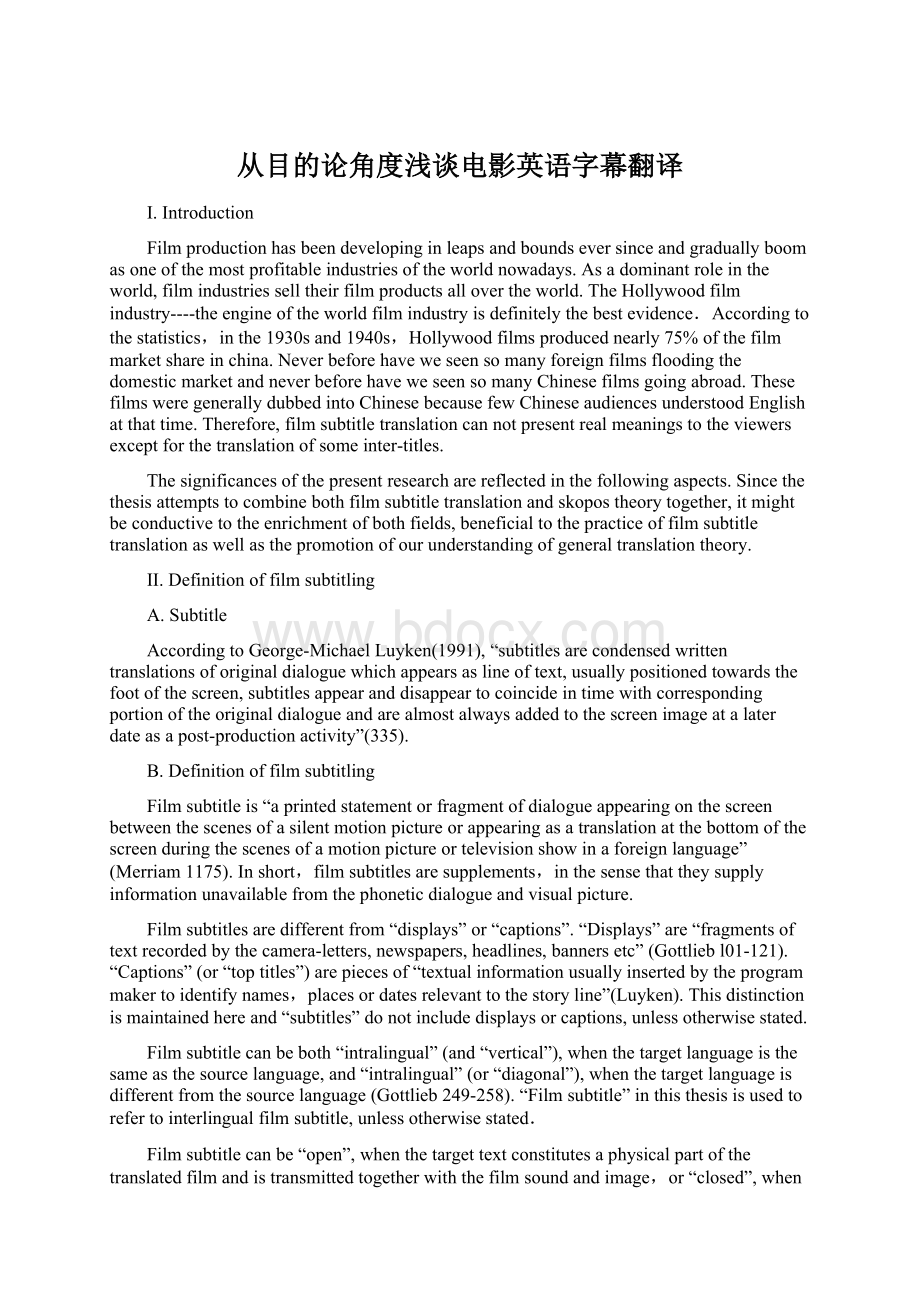从目的论角度浅谈电影英语字幕翻译.docx
《从目的论角度浅谈电影英语字幕翻译.docx》由会员分享,可在线阅读,更多相关《从目的论角度浅谈电影英语字幕翻译.docx(10页珍藏版)》请在冰豆网上搜索。

从目的论角度浅谈电影英语字幕翻译
I.Introduction
Filmproductionhasbeendevelopinginleapsandboundseversinceandgraduallyboomasoneofthemostprofitableindustriesoftheworldnowadays.Asadominantroleintheworld,filmindustriesselltheirfilmproductsallovertheworld.TheHollywoodfilmindustry----theengineoftheworldfilmindustryisdefinitelythebestevidence.Accordingtothestatistics,inthe1930sand1940s,Hollywoodfilmsproducednearly75%ofthefilmmarketshareinchina.NeverbeforehaveweseensomanyforeignfilmsfloodingthedomesticmarketandneverbeforehaveweseensomanyChinesefilmsgoingabroad.ThesefilmsweregenerallydubbedintoChinesebecausefewChineseaudiencesunderstoodEnglishatthattime.Therefore,filmsubtitletranslationcannotpresentrealmeaningstotheviewersexceptforthetranslationofsomeinter-titles.
Thesignificancesofthepresentresearcharereflectedinthefollowingaspects.Sincethethesisattemptstocombinebothfilmsubtitletranslationandskopostheorytogether,itmightbeconductivetotheenrichmentofbothfields,beneficialtothepracticeoffilmsubtitletranslationaswellasthepromotionofourunderstandingofgeneraltranslationtheory.
II.Definitionoffilmsubtitling
A.Subtitle
AccordingtoGeorge-MichaelLuyken(1991),“subtitlesarecondensedwrittentranslationsoforiginaldialoguewhichappearsaslineoftext,usuallypositionedtowardsthefootofthescreen,subtitlesappearanddisappeartocoincideintimewithcorrespondingportionoftheoriginaldialogueandarealmostalwaysaddedtothescreenimageatalaterdateasapost-productionactivity”(335).
B.Definitionoffilmsubtitling
Filmsubtitleis“aprintedstatementorfragmentofdialogueappearingonthescreenbetweenthescenesofasilentmotionpictureorappearingasatranslationatthebottomofthescreenduringthescenesofamotionpictureortelevisionshowinaforeignlanguage”(Merriam1175).Inshort,filmsubtitlesaresupplements,inthesensethattheysupplyinformationunavailablefromthephoneticdialogueandvisualpicture.
Filmsubtitlesaredifferentfrom“displays”or“captions”.“Displays”are“fragmentsoftextrecordedbythecamera-letters,newspapers,headlines,bannersetc”(Gottliebl01-121).“Captions”(or“toptitles”)arepiecesof“textualinformationusuallyinsertedbytheprogrammakertoidentifynames,placesordatesrelevanttothestoryline”(Luyken).Thisdistinctionismaintainedhereand“subtitles”donotincludedisplaysorcaptions,unlessotherwisestated.
Filmsubtitlecanbeboth“intralingual”(and“vertical”),whenthetargetlanguageisthesameasthesourcelanguage,and“intralingual”(or“diagonal”),whenthetargetlanguageisdifferentfromthesourcelanguage(Gottlieb249-258).“Filmsubtitle”inthisthesisisusedtorefertointerlingualfilmsubtitle,unlessotherwisestated.
Filmsubtitlecanbe“open”,whenthetargettextconstitutesaphysicalpartofthetranslatedfilmandistransmittedtogetherwiththefilmsoundandimage,or“closed”,whenthetargettextisstoredinadigital/teletextformatwhichistransmittedinaswellasaccessedviaaseparatelycodedchannelatthediscretionoftheviewers(Gottlieb247).Inthisthesis,“filmsubtitle”,referstoopenfilmsubtitle,unlessotherwisestated.
III.Abriefintroductiontoskopostheorie
A.Theprocessofskopos
SkoposistheGreekwordfor“aim”or“purpose”andwasinducedintotranslationtheoryinthe1970sbyHansJ.Vermeerasatechnicaltermforthepurposeofatranslationandoftheactionoftranslatingskoposfocusesonthepurposeofthetranslation,whichdeterminesthetranslationmethodsandstrategiesthataretobeemployedinordertoproduceafunctionallyadequateresult,thetargettext(TT),calledthetranslatumbyVermeer(20-23).Therefore,inskopostheory,knowingwhyansourcetext(ST)istobetranslatedandwhatthefunctionoftheTTwillbearecrucialforthetranslator.
Inthe1970sthereappearedaschoolintranslationstudiesinGermanyfunctionalism.KatharinaReissfirstlypointedoutinhisworkTranslationCriticism(2004).TherepresentativesareKatharinaReiss,HansJ.VermeerandChristianeNord.Theyholdthattranslationisakindofactionwithapurpose.ThistheoryisfirstpresentedbyReissandVermeerintheirbookGrundlegungeinerallgemeinenTranslationstheorie(1984)(GeneralFoundationsofTranslationTheory).
Since1978,GermantranslationtheoristH.J.Venneer,whobreaksthroughthetraditionalequivalence-basedthetheorythatcentersonsourcetext,createstheskopostheorieswiththetranslationpurposeorfunctionofatranslationasageneralprincipleonthebasisoftheoryofaction(23-24).Itisgenerallyagreednowthattranslationisatypeofhumanaction.AccordingtoVermeer,humanactionisintentionalandpurposefulbehaviorthattakesplaceinagivensituation,whichmodifiesthesituationatthesametime(205-210).Skoposarguesthattheshapeoftargettextshouldaboveallbedeterminedbythefunctionor“Skopos”thatitisintendedtofulfillinthetargetcontext.
Vermeerbelievesthatthepurposeofatargettextdeterminesthetranslationstrategies.Inhisopinion,thepurposeofatargettext,whichissoimportant,isgreatextentdecidedbytargetreaders,culturalbackground.InHansJVemeer’sSkoposandCommissioninTranslationalAction(1989),VemmerputstheSkopostheorieinthisway:
“Anyformoftranslationaction,includingthereforetranslationitself,maybeconceivedasanaction,asthenameimplies.Anyactionhasanaim,apurpose.ThewordSkopos,then,isatechnicaltermfortheaimorpurposeofatranslation.”InherbookTranslatingasaPurposefulActivity:
FunctionalistApproachesExplained(2001),ChristianeNorddefinestheskopostheoriethat“SkoposisaGreekwordforpurpose”(13-14).Accordingtoskopostheorie(thetheorythatappliesthenotionofSkopostotranslation),theprimeprincipledetermininganytranslationprocessisthepurpose(skopos)oftheoveralltranslationalaction.Thisfitsinwithintentionalitybeingpartoftheverydefinitionofanyaction.
B.ThreerulesoftheSkopostheorie
Skopostheoryinvolvesthreerules,i.e.skoposrule,coherenceruleandfidelityrule,whichwillbediscussedasfollows.
1.Skoposrule
Vermeerpostulatesthatasageneralruleitmustbetheintendedpurposeofthetargettextthatdeterminestranslationmethodsandstrategies.Fromthispostulate,hederivestheskoposrule:
Humanaction(anditssubcategory:
translation)isdeterminedbyitspurpose(Skopos),andthereforeitisafunctionofitspurpose(Baker236).
VermeerexplainstheSkoposruleinthefollowingway,
“Eachtextisproducedforagivenpurposeandshouldservethispurpose.Theskoposrulethusreadsasfollows:
translate/interpret/speak/writeinawaythatenablesyourtext/translationtofunctioninthesituationinwhichitisusedandwiththepeoplewhowanttouseitandpreciselyinthewaytheywantittofunction”(29).
Itisalsopointedoutthatmosttranslationalactionsallowavarietyofskopos,whichmayberelatedtoeachotherinahierarchicalorder,andthetranslatorshouldbeabletojustifytheirchoiceofaparticularskoposinagiventranslationalsituationintranslation,.,theskoposmustbedecidedseparatelyineachspecificcase.
Skoposrulehelpsthetranslatorsolvetheeternaldilemmasoffreevs.faithfultranslation,dynamicvs.formalequivalence,andsoon.Nordpointsoutthattheskoposofaparticulartranslationtaskmayrequirea“free”ora“faithful”translation,oranythingbetweenthesetwoextremes,dependingonthepurposeforwhichthetranslationisneeded.(29).
2.Thecoherencerule
Twofurthergeneralrulesarethecoherenceruleandthefidelityrule.Thecoherencerulestipulatesthatthetargettextmustbesufficientlycoherenttoallowtheintendeduserstocomprehendit,giventheirassumedbackgroundknowledgeandsituationalcircumstances.
Thecoherencerule,orinVermeer’sterms,thestandardof“intra-textualcoherence”means“thereceivershouldbeabletounderstandit:
itshouldmakesenseinthecommunicativesituationandcultureinwhichitisreceived”(Nord32).Thecoherencerulespecifiesthat“atranslationshouldbeacceptableinasensethatitiscoherentwiththereceivers’situation”(Nord32).
Thatistosay,thetranslator’staskistoproduceatextthatisatleastlikelytobemeaningfultotarget-culturereceivers,namely,tobecoherentwiththereceivers’situationandthustobeunderstoodbythereceivers.Onlywhenthereceiversunderstanditasbeingsufficientlycoherentwiththeirsituation,canthiscommunicativeinteractionberegardedassuccessful.
3.Thefidelityrule
However,justbeingcoherentwiththetargetsituationisnotenough.Atranslationisanofferofinformationaboutaprecedingofferofinformation;thereforethereisarelationshipbetweenthetranslationandthesourcetext.Vermeercallsthisrelationship“inter-textualcoherenceor“fidelity”.Thisispostulatedasafurtherprinciple,referredtoasthe“fidelityrule”(Nord32)
“Inter-textualcoherenceshouldexistbetweensourceandtargettext,whiletheformittakesdependsbothonthetranslator’sinterpretationofthesourcetextandonthetranslationskopos”(Nord1-32).Forexample,onepossiblekindofinter-textualcoherencecouldbeamaximallyfaithfulimitationofthesourcetext.
Weknowthatthesourcetextisintendedforthesourceculturereceiversinsteadoftranslation,thereforewhenitistranslatedforthedifferenttarget-culturerecipients,maybethefunctionofthetargettextorthepurposeofthetranslationisdifferentfromthatoft